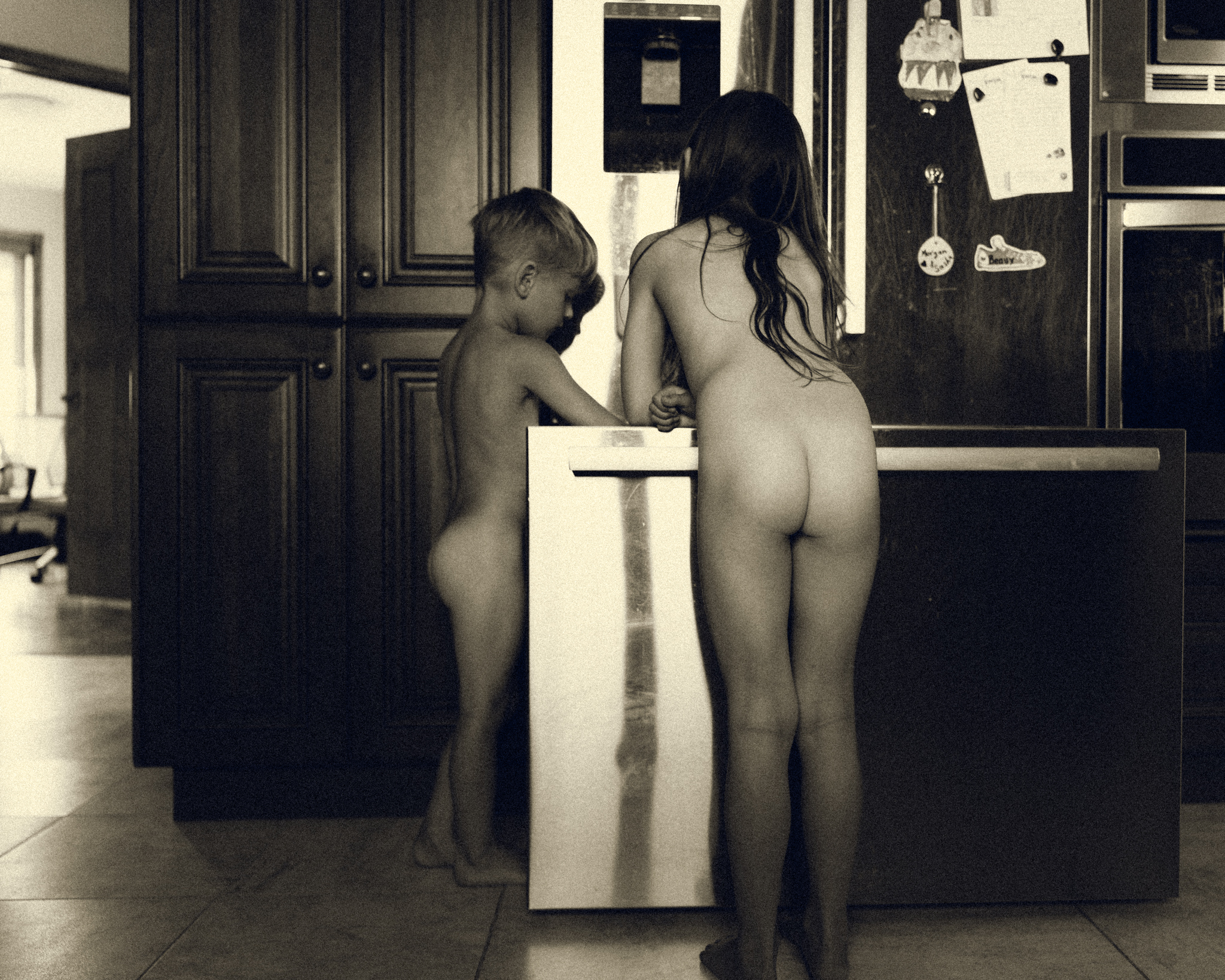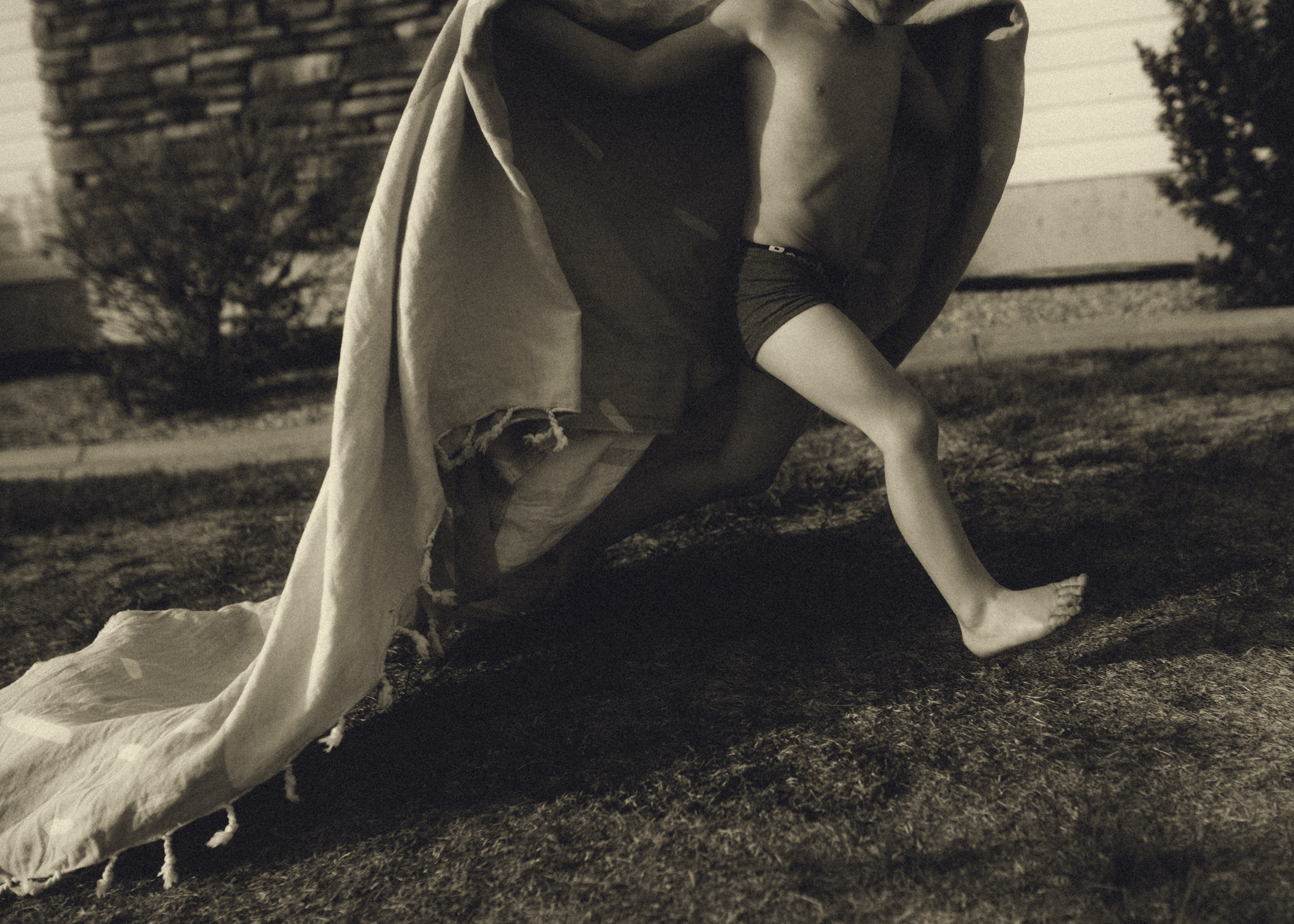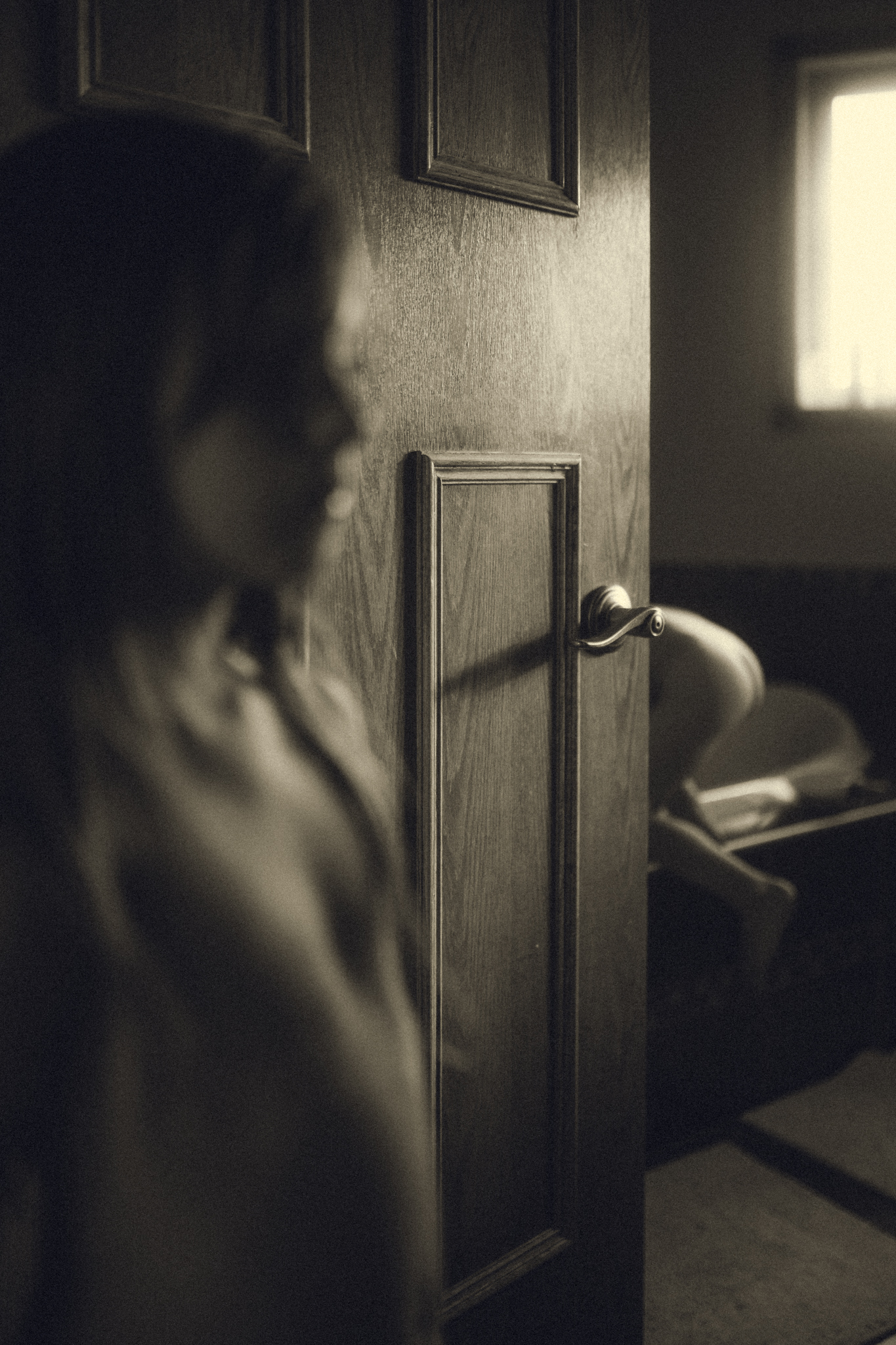Is it unethical to photograph a naked child?
At what age does child nudity become inappropriate?
Where is the line between child pornography and documenting childhood in the natural state of nakedness?
These are questions that have been on my mind since I started my photography journey. As someone who loves to use skin in my images to symbolize vulnerability, rawness, and emotion, I’ve had to grapple with what that means for me as I photograph my own children. Personally, I do believe there is a palpable difference between documenting the pure and wild nature of childhood without clothing and child pornography, but meaning is found not only in artistic intent but through the gaze of the viewer. So how are we to know how such an image might be received?
Well, we can’t.
A child would not take a picture of themselves naked uncoerced. Yet it is obvious that not all nude imagery is pornographic. It might help to ask ourselves, what is the nature of a pornographic image? The Oxford reference defines a pornographic image as an image “that has been produced solely or principally for the purpose of sexual arousal.” There are many indicators that an image is in fact, pornographic (posing that conjures thoughts of sexual activity, etc.), yet when the image features a child these indicators seem to go out the window.
Photographer Sally Mann, who came to worldwide recognition through her nude photos of her children, talks about the complexities of the nude child in art in her autobiography Hold Still, “In the pictures of my children I celebrated the maternal passion their bodies inspired in me – how could I not? – and never thought of them sexually or in a sexual context…when I saw their bodies and photographed them, I never thought of them as being sexual; I thought of them as being simply, miraculously, and sensuously beautiful…I was puzzled why that sensuous beauty should be signposted as controversial while at the same time magazine pages were filled with prurient images of young girls, all aimed at selling commercial products.” (158) In a culture that touts ‘sex sells’, the use of sexual imagery has become so normalized that we struggle to separate a nudity from sexuality when in fact, our naked bodies are used for much more than just sex. This problem may have its roots in that we haven’t yet normalized visual representation of non-sexual nude imagery.
Mann goes on to say “All perception is selection…photographs economize the truth; they are always moments more or less illusorily abducted from time’s continuum” (151). Yet the modern rise and prominence of child pornography challenges her sentiment. The existence and reality of child exploitation and sexual abuse is a very real one and imagery plays a serious role and we have to take that into consideration.
CONSENT
Mann states that the responsibility of the artist is to maintain the dignity (141) of your subject and to discuss with them your intent and gain their consent for such images, as she spoke with her own children frequently about their comfortability with the photographs she took. I personally struggled with this sentiment because the concept itself begs the question; can a child give informed consent? Can they understand the implications of being photographed naked and the possible consequences of being a subject within a piece of art that may be showcased? No, they cannot. Mann’s own children objected to some of her photographs being included in her Immediate Family series (and for this reason Mann did not include them), yet it is interesting that they never cited nudity as one of their concerns. I think it’s quite likely that children only find nudity strange, inappropriate, or shameful if the adults in their lives do. Yet this still does not address the issue of informed consent.

When her morality came under fire for her work, Mann replied, “I’m going to go out on a limb here and say that I believe my morality should have no bearing on the discussion of the pictures I made. Suppose, for the sake of argument that I actually was…”manipulative”, “sick”, “twisted,” vulgar”. Even if I were all of those things, it should make no difference in the way the work is viewed, tempting as it is to make that moral connection. Do we deny the power of For Whom the Bell Tolls because its author was unspeakably cruel to his wives? Should we vilify Ezra Pound’s Cantos because of its author’s nutty political views? Does Gauguin’s abandoned family come to mind when you look at those Tahitian canvases? If we only revere works made by those with whom we’d happily have our granny share a train compartment, we will have a paucity of art” (153). This is important because it addresses the concept of morality in art. On one hand I think it’s unreasonable to expect that good art can only be accepted and acknowledged when made by those with “good morality” – as “good morality” often translates to “those who think, believe, and value what I think, believe, and value.” Yet a piece that Mann’s argument misses is agency. Ernest Hemmingway may have been an asshole to his wives, but his wives were adults with the ability to make informed decisions about a relationship with him. They had agency. A child does not understand the many implications of their naked body being photographed and viewed by the world and relies on the adults in their lives to make informed decisions on their behalf.
CULTURAL NARRATIVES

Mann says that “part of the artist’s job is to make the commonplace singular, to project a different interpretation onto the conventional… I think they [her family pictures] tapped into some below-the-surface cultural unease about what it is to be a child, bringing into the dialog questions of innocence and threat and fear and sensuality and calling attention to the limitations of widely held views on childhood (and motherhood)” (153). This is important because it illustrates the need for cultural shifts. Nakedness cannot be reduced to symbolize sex alone and “All too often, nudity, even that of children, is mistaken for sexuality and images are mistaken for actions. All contact is not necessarily sexual, all looking is not transgression, and of course, appearances can deceive…children are not just the innocents that we expect them to be. They are also wise, angry, jaded, skeptical, mean, manipulative, brooding, and devilishly deceitful…but in a culture so deeply invested in a cult of childhood innocence, we are understandably reluctant to acknowledge these discordant aspects, or, as I found out, even fictionalized depictions of them.” (Mann 157) Our culture is obsessed with the idea of childhood innocence and purity which is why it struggles so vehemently when a child does something we would consider “evil” or “unnatural”. We quickly pathologize the child instead of questioning our cultural narratives surrounding childhood and what is natural/ unnatural given the circumstance and situation. Mann makes an interesting point when she says “even fictionalized depictions of ” these discordant aspects of childhood. Putting nudity aside for a moment, I can’t begin to tell you how many people I have had assume that my daughter is a sad child because I don’t tend to showcase images of her smiling. They believe that what they see on my social media is a reflection of her truth, which it is not. It is a reflection of MY truth. What the average person perusing my images doesn’t see is the hundreds of times she breaks “character” and laughs, or begins the session grinning ear to ear. I ask her to look moody, often modeling the expressions I’d like her to copy for the photo. The child you see in my images of my daughter is not her, it is me 30 years ago. Just as a smiling child in a photograph does not indicate happiness in their environment, a frowning child in a photograph does not indicate misery. Photographs don’t always tell the truth. To frame is to exclude, and there is always an intention behind a picture, professionally taken, or otherwise.
ENVIRONMENT
Environment is another factor that needs to be considered. The environment in which Mann was photographing her children was outside the realm of mainstream. On their private family farm, the children were free to roam, swimming and basking in the sunlight nude. Perhaps part of the problem generated by her family images was not in the images themselves, but in the perverted world that viewed them. In an age so estranged from nature, it’s no surprise that something as natural as nakedness would quickly become taboo. The naked body reminds us that we are made of matter; walking dirt with fantasies of becoming divine. When something natural becomes taboo, it begins to be viewed as erotic. Unwilling to address the profound issues that arise with separating ourselves from the rest of creation, our modern culture fails to differentiate between deviance and innocence. In reality, it is “natural…to allow our children to run naked” (Mann 162). Most young children are indifferent to nudity, whether they come from town dwellers or country folk, and since the first means of human connection happens through skin-to-skin contact, a level of nudity is required. We have no qualms about the nakedness of infants; babies in their diapers are often photographed with no concerns whatsoever as they have to be disrobed often in order to change them and keep them clean so nakedness is already a common, acceptable, and normalized occurrence. Yet it is the solitude of the country that allows for the naked exploration of our youth past infancy, and I think environment is an important aspect of this inquiry. Allowing one’s children to run naked in the streets would not only be frowned upon, but it would be unsafe.

I often say that I live in a naked house. My children and I see each other naked regularly. They see me get out of bed in the morning in my underwear and also see me come out of the shower. Nakedness in our house has never been a source of shame, strangeness, or unsafety. As a self-portrait artist, my children also see me take nude pictures of myself frequently. They see me comfortable with and unphased by nudity on a daily basis, but they also see me cover up when someone comes up the driveway and we put clothes on before we go to town. Our environment allows for safe naked expression, but before we leave our own environment, we suit up.
REAL TIME EXAMPLES
Let’s look at a few scenes:
- A hot sunny day on an acreage. A naked child running through the grass, playing in the dirt and the water to cool down. Their mother, seeing beauty in their wildness, documents it with her camera while encouraging them subtly in order to get the shot she envisions, without disrupting their play.
- A photographer’s studio /or photoshoot. A fully clothed child arrives (because we don’t take our kids out of our yard without clothing them) and is disrobed in front of a stranger and their camera.
- A photographer meets a family at their home. The family has set up water balloons to play with while photos are being taken and the children put on swimsuits to play in the water as would naturally happen if there was no photographer present and the photographer takes pictures of their play.
Scene 1 and Scene 3 are natural and un-cohersed. However for me, scene 2 is problematic. Personally I think the problem comes in when we are asking children to get naked for photos. I hardly think it’s inappropriate to take nude photos of children if the situation/scenario already invites nudity in some form (ie. the kids are already sans clothing, or we are at the beach and they want to go in the water, etc.) If the session was located on a beach and the child wanted to go into the water and the advent of nakedness was organic without coercion, I personally see nothing wrong with documenting that. But if we are taking children out of a space where nudity is appropriate and considered safe, and then taking their clothes off, well this begins to invite some understandable concerns.
Does this mean that we as photographers should not be taking nude motherhood pictures in a studio setting? Or at what age would this scenario become inappropriate? Maybe the answer is, whatever age a child displays discomfort with disrobing in front of non-family members.
AN ONGOING CONVERSATION
So should we as photographers be taking naked pictures of children? I think that’s a question every photographer has to answer for themselves. I think it’s important to ask ourselves this question, and it’s equally important to do our research and deeply inquire as to why we want to showcase nudity. As artists all we can do is know the difference between sexual and non-sexual imagery and work toward an artistic ethic that protects the vulnerable. For me, I side more with Mann than I do our current culture. Like Mann’s own children, I grew up running naked through trees, bathing in rivers, peeing in tall grass and feeling the blades scratch my skin. As a child, I used my naked body to feel the earth around me. Nudity is symbolic of nature, our natural state. As someone working toward making a connection with nature a top priority in my work I cannot exclude it, be my subjects adults or children. Childhood is precious, a moment in time where we are for the most part, free of the grown up games we call civilization. I want to remember my children in their wildness, their rawness, and in the moments they were unafraid of their own bodies and how the world might view them. I want them to have images to look back on that remind them of that time too. Images that point them back to the freedom and beauty of their childhood, that point them back to nature. I want to leave them reminders that their mother saw their bodies as sacred, places of wildness and purity; untainted by the perversions of our culture. So for me as an artist, the answer is yes, I will take nude picture of my children, but I will do so with the intention of challenging our cultural narrative on the intention of nude imagery and strive toward contributing to an artistic body of work that points us back to nature.
